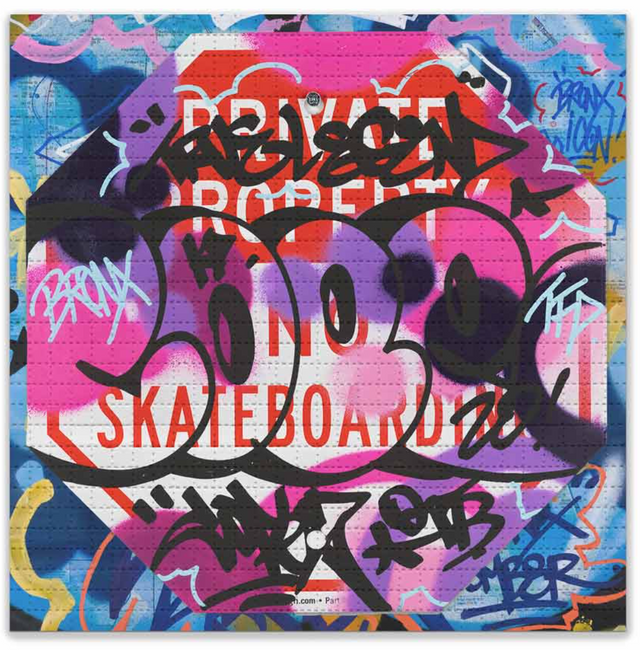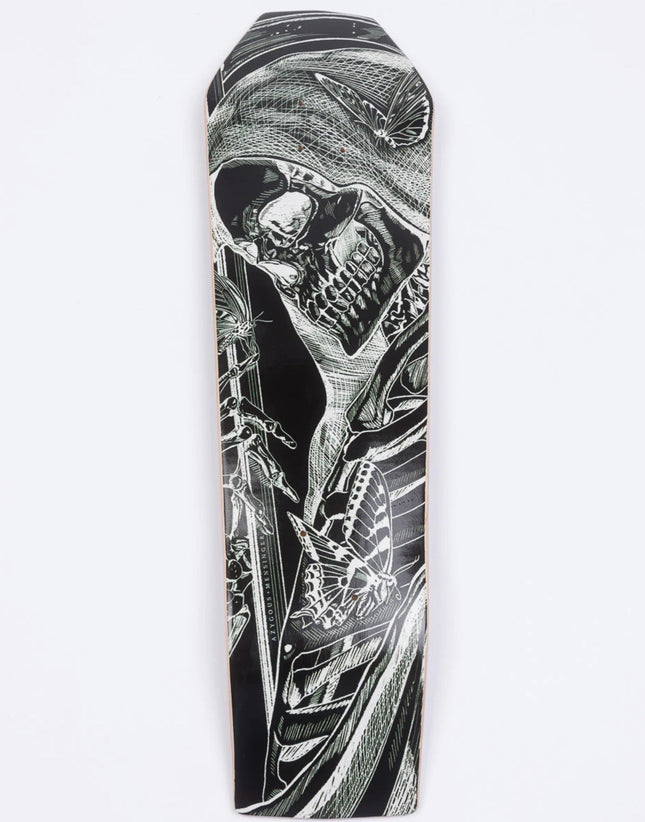
Skateboarding

Donatella Azygous Coffin Deck Skateboard Art Deck by Justin Mensinger x Donatella Azygous
Coffin Deck Fine Art Limited Edition Archival Pigment Print Transfer on Wood Skateboard Deck by Street Artwork Graffiti Artist Justin Mensinger x Donatella Azygous. 2022 Limited skate deck made in collaboration with Donatella Azygous Custom carved coffin-shaped cruiser board 9X31.5 Coffin Deck Skateboard Art Deck by Justin Mensinger x Donatella Azygous Skateboarding Meets Street Art: The Coffin Deck Collaboration The Coffin Deck is a remarkable manifestation of how street artwork and skate culture intertwine, creating a piece that is both a functional item and a work of art. This limited edition skateboard deck, a collaborative creation by Justin Mensinger and Donatella Azygous, exemplifies how street pop art can transcend traditional canvases and infuse everyday objects with profound artistic expression. Artistic Fusion on Four Wheels Justin Mensinger, known for his work that often features elements from street culture, partnered with the enigmatic artist Donatella Azygous to produce a piece steeped in graffiti and street art aesthetics. The Coffin Deck, with its archival pigment print transfer on wood, brings the raw energy of street art into the hands of skateboarders and art collectors alike. The coffin shape of the board is a nod to the underground, rebellious spirit of skateboarding culture, symbolizing a departure from the mainstream and an embrace of the niche and the novel. The deck's design, marked by the stark contrast of black and white, features a skeletal figure that merges with intricate patterns and natural motifs such as butterflies. This juxtaposition of the macabre with the delicate suggests a more profound commentary on life, death, beauty, and decay – recurrent themes in pop and street art. Each deck, custom carved and sized at 9X31.5 inches, stands as a unique testament to the skill and creative vision of the artists involved. Confluence of Symbolism and Street Sensibilities In creating the Coffin Deck, Mensinger, and Azygous tap into the symbolic language of street pop art, where every image and every line is loaded with meaning. Using a skateboard as a medium is a statement, positioning the artwork within skate culture's rebellious, free-spirited world. It is a culture historically shared a symbiotic relationship with street art, each influencing and inspiring the other. The skeletal figure at the center of the design is reminiscent of the memento mori theme, a reminder of mortality richly woven into the fabric of pop art's history. Meanwhile, the butterflies suggest transformation and rebirth, offering a counterpoint to the somber undertones of the piece. Together, these elements create a conversation about the cycles of nature and humanity, encapsulated on a platform that is as much about movement and freedom as it is about artistic expression. The Legacy of Street Art in Skateboard Design The collaboration between Justin Mensinger and Donatella Azygous is not just a fleeting moment in the vast timeline of street pop art; it represents the ongoing legacy of street art's influence on design and culture. The Coffin Deck is a contemporary artifact that captures the essence of a movement – one that continues to challenge conventional views on art and its place in society. These limited-edition skateboard decks are collectors' items, but more importantly, they are pieces of a cultural dialogue that stretches back to the origins of street art and graffiti. With each deck, Mensinger and Azygous contribute to this conversation, adding their unique voices to a story constantly unfolding beneath the wheels of skaters and the brushes of street artists worldwide. The Coffin Deck by Justin Mensinger and Donatella Azygous is a poignant example of street pop art’s versatility and capacity to make a statement, whether on city walls or underfoot in a skate park. Through this piece, the artists celebrate the intersection of life, death, and the irrepressible spirit of street culture, crafting an object that is both a tribute and a challenge to the ever-evolving art form.
$320.00


